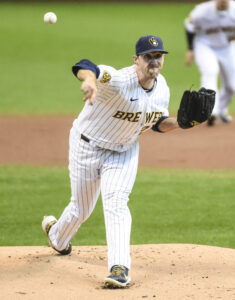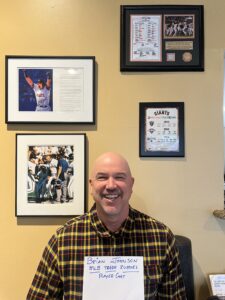The Cubs and Dodgers didn’t make a trade this offseason, but a series of transactions effectively added up to one. Here’s what I mean.
- August of 2022: Cubs president of baseball operations Jed Hoyer announces they will release Jason Heyward at the end of the season.
- November of 2022: Heyward officially released.
- November of 2022: Cody Bellinger is non-tendered by the Dodgers.
- December of 2022: Cubs sign Bellinger to one-year deal.
- December of 2022: Dodgers sign Heyward to a minor league deal.
Both clubs had a long-tenured outfielder that was posting disappointing results. In both cases, they could have kept the player for one more year. Heyward still had one season left on his contract while Bellinger still had one arbitration season remaining. But in both cases, the club decided to cut bait, then swooped in to collect the other team’s castoff.
Now each club is going to be trying to coax a bounceback season from their respective new outfielder. In a vacuum, the Cubs are more likely to succeed. Bellinger has struggled over the past two years, producing a dismal .165/.240/.302 batting line in 2021 and then a subpar .210/.265/.389 slash last year. However, he was above average in 2020 and was the National League’s Most Valuable Player in 2019. He launched 47 home runs in that MVP season while hitting .305/.406/.629 for a wRC+ of 161. He also stole 15 bases and was graded well for his defensive work, being deemed to be worth 7.7 wins above replacement, according to FanGraphs.
Heyward, on the other hand, has never really touched that kind of ceiling, and certainly not recently. He had a strong showing at the plate in 2020 but hasn’t been an above average hitter in a full season since 2015. He hit .293/.359/.439 for the Cardinals that year, leading to a 121 wRC+. He also stole 23 bases and was strong in the field, leading to a 5.6 fWAR tally. However, he’s been well below that type of production since then, including being below replacement level last year.
Bellinger was himself below replacement level in 2021, but that was at least partly caused by shoulder issues. Both players have struggled in recent years but Bellinger was an MVP not too long ago. Heyward has never been on that tier and hasn’t been close in almost a decade. Bellinger also plays the more premier position, as he figures to be the Cubs’ everyday center fielder. Heyward has played center on occasion but has primarily been a right fielder in his career. Given that Bellinger is only 27 years old and Heyward is 33, the likelihood of a return to form would seem to be stronger with Bellinger.
The Cubs seem to have backed the horse more likely to end up in the winner’s circle, but they also have way more on the line. Heyward still had $22MM left on his deal when he was released and the Cubs are still on the hook for that. Assuming he is eventually added to the Dodgers’ roster, they will only be responsible for paying him the prorated league minimum, with that amount subtracted from what the Cubs pay.
Bellinger, on the other hand, isn’t owed anything by the Dodgers since they didn’t tender him a contract for this year. The Cubs brought him aboard by guaranteeing him $17.5MM, in the form of a $12.5MM salary and $5MM buyout on a mutual option for 2024. That means that the Cubs are paying the salaries of both players, with the figures combining to be worth almost $40MM. The Dodgers aren’t really committed to either player right now and won’t even be paying meaningful money if Heyward does make the team.
Heyward’s chances of cracking the roster seem to have increased lately. With Gavin Lux potentially out for the entire season, it seems that Chris Taylor will be spending more time on the infield and less in the outfield. That subtracts from the club’s outfield depth a bit, perhaps increasing the need for a non-roster invitee like Heyward.
There’s also a bit of positive buzz around Heyward in spring so far. Last month, Freddie Freeman told reporters, including Alden González of ESPN, that Heyward had altered his stance and “might have unlocked something.” Heyward has four hits in ten at-bats so far this spring, including a pair of home runs. A few good spring games don’t mean much and it’s dangerous to draw meaningful conclusions from them, but it’s nonetheless encouraging, especially given the club’s penchant for helping journeymen find the best versions of themselves. Jon Heyman of the New York Post wrote last week that Heyward is impressing L.A. officials and expected to make the team.
Again, this isn’t to get carried away. The season hasn’t even begun and a few good spring games shouldn’t make us forget about Heyward’s past six full seasons. It’s entirely possible that he continues to disappoint and this hot spring eventually becomes a footnote. But the Dodgers have little to lose in that case. It might be a bit embarrassing if Bellinger returns to form after they let him go for nothing. But at least they saved his salary, which was projected to be $18.1MM by MLBTR contributor Matt Swartz. They were then able to redirect that money into players like Noah Syndergaard and J.D. Martinez, who will cost $23MM combined this year.
The Cubs are perhaps facing a much more cringeworthy worst-case scenario. There is some non-zero chance that they have to watch Heyward thrive in Los Angeles while Bellinger struggles in Chicago, as they pay the salaries of both players. Time will tell whether that scenario is likely or not, but the Cubs have almost forty million reasons to hope it doesn’t come true.


